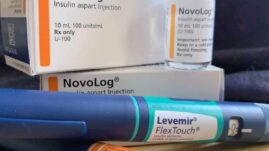While there are many different types of insulin glargine, two of the most popular are Lantus and Basaglar.
Lantus was introduced to the market in 2000 and Basaglar was introduced as a “biosimilar” option in 2015
Lantus and Basaglar are both prescribed to treat patients with type 1 and type 2 diabetes and are very similar, but not always interchangeable.
This article will explain these two popular types of insulin, their uses, and which may be a better option for you.
The need for basal insulin
All people, whether or not they have diabetes, require insulin to live. People with diabetes, however, either cannot make their own insulin, or their body fails to use the insulin their body produces properly (some people with type 2 experience this in the form of insulin resistance).
People who choose not to use insulin pump therapy and are thus on multiple daily injections (MDI) will require both basal and bolus insulins.
Basal insulin or “background” insulin has one primary job: to keep your blood sugars level when you’re not eating (when you’re fasting) and overnight when you’re asleep.
Long-acting (basal) insulin is unique in the sense that it slowly releases the insulin you inject over a longer period of time, as opposed to short-acting insulin which releases and is absorbed much faster in the body.
Long-acting insulin works well with bolus insulins (short-acting insulin) that is taken for all foods (especially carbohydrates) consumed.
Since all humans require insulin all the time to live, even without eating anything, a person with diabetes will experience severe hyperglycemia (high blood sugar) if they do not take basal insulin.
There are different categories of long-acting insulin:
- Intermediate-acting insulin (NPH), peaks at 8 hours, lasts 12-16 hours
- Long-acting insulin (detemir or glargine), no peak, lasts about 24 hours
- Ultra-long acting insulin (degludec), no peak, lasts up to 42 hours
The most common form of long-acting insulin is glargine. There are two brand names of glargine available: Basaglar and Lantus.
What is Lantus?
Lantus was first developed by the insulin manufacturer Sanofi in 2000 and is used to treat both type 1 and type 2 diabetes.
Lantus was one of the first longer-acting insulins on the market, making modern-day carbohydrate counting, taking insulin for food eaten (instead of the other way around), and insulin to carbohydrate ratios a reality.
The introduction of Lantus was revolutionary to people on multiple daily injections, as adding in a basal insulin got rid of the necessary snacking throughout the day that was required to counter the peaks of intermediate-acting insulins like NPH.
The introduction of Lantus on the market greatly decreased the number of nocturnal hypoglycemic events people with diabetes experienced, due to its lack of a peak, and its steady, slow release of insulin over a 24 hour period, and improved the lives of many people living with diabetes. It is still a very popular option for people who are on MDI.
Lantus comes in both an insulin vial and insulin pen version.
What is Basaglar?
Basaglar, developed by Eli Lilly & Company, was first introduced in 2015. The reason for the 15-year delay was that Lantus was patent-protected for the first 15 years, and until those patents expired, other insulin manufacturers could not make similar insulins that would compete for market share.
Basaglar was the first “biosimilar” insulin to be approved by the Food and Drug Administration as well as the first to launch in the United States, paving the way for more affordable options on the insulin market.
Other pharmaceutical companies, such as Mylan/Biocon and Merk/Samsung Bioepis are also working on biosimilar glargine insulins as well, which should drive down prices as competition increases.
Similar to Lantus, Basaglar has a slow release over a 24 hour period and has no peak.
While the two insulins perform remarkably similarly (including the same protein sequence and blood sugar-lowering effects), their chemical formularies are ever so slightly different, so people with diabetes cannot simply switch out one type of insulin for the other without their doctor’s guidance.
Basaglar is only available via an insulin pen called the Kwikpen.
What is the difference between these two insulins?
While these insulins are remarkably similar, people may react differently to their chemical makeup.
Adverse events such as slower absorption times, skin irritation, or seeing a slight peak (although uncommon, it may happen) may happen to you if you try one insulin and not if you try the other.
Always work with your provider to see what the best option is for you.
Another main difference between these two insulins is the cost. The out-of-pocket cost for each in the United States is:
- Lantus: $425 for 5 pens (300 units a piece) or around $285 for one vial (1,000 units)
- Basaglar: $326 for 5 pens (300 units a piece)
This makes sense, as Basaglar was introduced as a more affordable option to Lantus.
Is Lantus or Basaglar more effective for blood sugar control?
The two insulins are equally effective for blood sugar control. Any differences you may experience are the result of your individual reaction to the insulin and not because one brand is superior to the other.
Can you substitute Lantus for Basaglar?
Basaglar is not a generic equivalent of Lantus, and therefore, the two are not interchangeable.
Although Lantus and Basaglar contain the same active ingredient, they are made differently and by different companies. This means that Basaglar is not an exact replica of Lantus.
If you are prescribed one and would like to switch to the other, your doctor will need to write you a new prescription. Your pharmacist cannot just substitute one for the other without your doctor’s approval.
What are the side effects of these two insulins?
The main side effect of these two insulins is hypoglycemia (low blood sugar). Symptoms of hypoglycemia include:
- Headache
- Weakness
- Sweating
- Increased heart rate
- Troubling concentrating
- Hunger
- Fainting
- Shakiness
- If severe, seizure
Other common side effects of glargine include:
- Skin irritation at the injection site
- Redness at the injection site
- Pain and swelling at the injection site
- Thickening or hollowing of the skin at the injection site
Speak with your doctor if you’re pregnant, planning on becoming pregnant or breastfeeding and wish to start glargine. Your insulin requirements will vary during and after pregnancy.
Which one is the right type of insulin for me?
There are many reasons why people choose one of these insulins over the other. You may have a very specific preference for the type of long-acting insulin that you choose.
Perhaps you do not want to use an insulin pen (and you’ll want to go with Lantus), or perhaps you will ONLY use an insulin pen (making Basaglar your insulin of choice).
Maybe you experience an adverse reaction to one type of insulin and not the other (pain, swelling, itching, redness or swelling at the injection site are common side effects of both Lantus and Basaglar).
Perhaps your body metabolizes one insulin better than the other. Some people may find that one insulin or the other doesn’t quite last a full 24 hours, and they need to split their dose.
To know for sure, you should work with your provider to see what they recommend.
Talk about your lifestyle and health goals, and seek their advice, but both insulins come highly rated, and choosing the best one for you and your diabetes management is ultimately up to you!



barbara morrissey
Have had T1DM for 40yrs. 80 yrs old now.Went to get a refill on Levemir and was told my Medicare Advantage insurance would no longer pay, have to switch to Lantus. I really want to stay on Levemir since it works so well for me,(HG A1C between 7 and 7.5) Especially am worried about hypoglycemia.Feel like I am being experimented with in the name of “lower prices”. Also don’t see my endocrinologist for three more months.
Think my insurance did a very poor job of warning me of this change. Also think it and the pharmacy should have contacted my endo about this change, instead of dispensing me the mandatory supply of Levemir (one month) and leaving it up to me.
Christel Oerum
That’s beyond frustrating. When I’ve been switched by insurance companies they’ve usually sent me a letter beforehand but Medicare might not. One approach that has worked for me is to try the drug they want you to use and if it doesn’t work as well or if you have a reaction to it let your doctor know, the doctor will then let your insurance know that it doesn’t work for you, and you can potentially go back to Levemir. But that’s a process
Russell E Mason
I have insurance but lantus kwick pens are expensive.
Christel Oerum
Have you tried to see if you can use the Lantus copay card? You can find the link here: https://diabetesstrong.com/how-to-save-money-on-insulin-with-copay-cards/